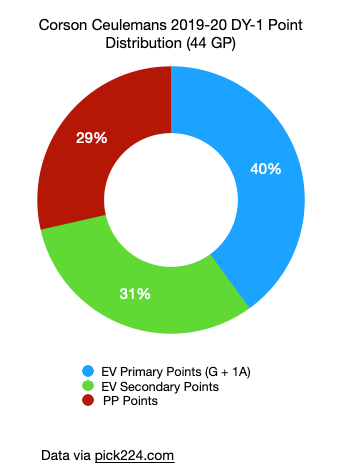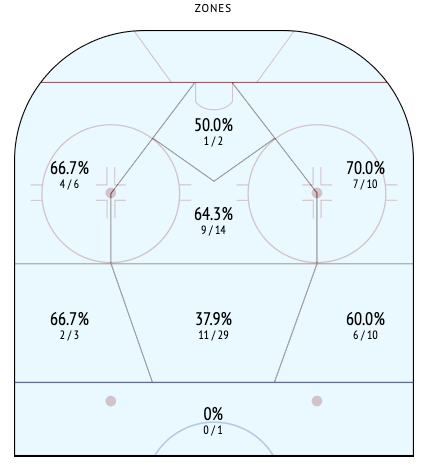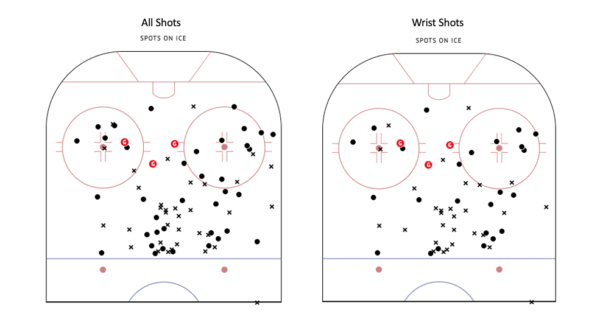PROSPECT PLAYBOOK: Breaking down Ceulemans’ game
With FCHockey’s Winter rankings for the 2021 NHL Draft officially being released, the time felt right to produce my inaugural piece examining one of the draft’s most polarizing players: FCHockey’s No. 17 ranked prospect: Corson Ceulemans of the AJHL’s Brooks Bandits.
Overview
Ceulemans, who has committed to the University of Wisconsin for the 2021-22 season, has been a fascinating player to watch. He boasts a large and rangy frame at six-foot-two, 192 pounds and possesses a high-end offensive skillset. His four-way skating is agile and crisp – which when combined with his hard, accurate passing (87% pass completion rate in the last nine games of his DY-1) – allows him to thrive in transition. When the puck is on his stick in the OZ or an offensive opportunity presents itself, Ceulemans’ eyes light up. He’s not afraid to sprint to join offensive rushes, nor is he shy about initiating the rush himself. He’s a volume shooter, but an effective one. Ceulemans doesn’t just settle for point shots. He gets a ton of pucks on net from lower in the offensive zone thanks to his ability to evade defenders and manufacture space for himself, utilize the offensive zone funnel, and sneak down weak side OZ lanes for seam passes. Thanks to his ability to generate shots for his team (either himself or setting others up), he proves to be a strong possession player, having posted a 58 Corsi For% (CF%) during his final nine games of the 2019-20 season with Brooks.
RELATED: PROSPECT SPOTLIGHT: CORSON CEULEMANS
Ceulemans has a world of talent offensively. Anyone who watches him can see it. It’s when he’s on the defensive side of the puck that things get… interesting. Especially in the defensive zone. Without the puck in the DZ, he’s often rather disengaged from the play. Specifically, he often stands in a casual, straight-up-and-down position with minimal play readiness, which necessitates an extra half-to-full second of reaction time when an offensive player approaches his area of the ice and he has to act. This is a cause for concern for me, especially considering the slightly lesser league he plays in. If he wants to make his transition from the AJHL to an elite NCAA program like Wisconsin as smooth as possible, he’ll have to really improve his commitment to the defensive side of the puck.
Don’t get me wrong, Ceulemans has the capabilities to be an effective defender. When he wants to, he’s very effective at nullifying cycles and plays below the goal line thanks to his reach, strength, and ability to cut off an offensive player’s hands. He’s also a very strong neutral zone defender – able to angle offensive threats off the puck and routinely cut plays off early – thanks to his awareness, agility and anticipatory skills. He routinely displays this defensive prowess through the neutral zone, which is why it’s evident that the only thing holding Ceulemans back from being a stalwart in the defensive zone is a commitment to applying himself as a defender.
That being said, let’s take a detailed look at Ceulemans’ game through the numbers and video to determine what makes him such an enticing package of skating, skills and smarts entering the 2021 NHL Draft.
Ceulemans’ production
The first thing that jumps out about Ceulemans is his age-relative production. He racked up an impressive 35 points in 44 games in the AJHL in 2019-20. As per pick224.com, Ceulemans’ production ranks from 2020 as a DY-1 player are as follows:

Before Covid forced the AJHL to halt its 2020-21 season in November, Ceulemans was off to a scorching start. Through just two games, he had already posted five points (2G, 3A) to place himself in a three-way tie for second in points-per-game league wide. And while his per-game production rates are impressive and only growing, it’s how he generates his offence that impresses me.
For starters, the majority of his point production comes where it matters most: at even strength. Of his five points in 2020-21, four had already come at evens before the league shut down. In 2019-20, ~70% of his total points came at even strength, with 40% of them coming as primary points:

Ceulemans’ offensive proficiency at even strength represents a huge boon to his overall value as a prospect. He’s producing the lion’s share of his points when it’s hardest to do without relying on an exorbitant boost from the power play. And more often than not, he’s the one initiating the goal whether he’s scoring it himself or setting it up directly with a primary assist.
Quality shot generation + OZ funnel activation
The next portion of Ceulemans’ offence generation that impresses me the most is twofold:
- Shot quality
- Ability to utilize the entire OZ and leverage the OZ funnel to generate looks in tight
He produces a ton of shot volume (average of eight shots on goal [SOG] per game in the final 10 games of his DY-1), but his shots are typically very high in quality. Where many trigger-happy defensemen will simply fire pucks into masses of humanity to their own team’s detriment, Ceulemans routinely implements fakes, changes in release, and evasive maneuvers to generate shots closer to the net. This leads to his strong conversion rates of shot attempts (SA) to shots on goal (% rate = percentage of SA that are SOG):

Part of Ceulemans’ ability to generate such high-quality looks can be attributed to his heavy preference for wrist shots over any other form of shot. If we compare his shot chart with all shots to just wrist shots, nothing much changes:

He defers to wrist and snap shots in order to allow for the ability to implement pre-shot fakes and change shooting angles at the last second to get shots through:
Ceulemans also routinely shrinks the top of the offensive zone and takes advantage of the OZ funnel. If he can get lower in the zone to generate a better look, he’s going to:
Ceulemans has the offensive instincts and wherewithal (and clearly the green light from the Bandits’ coaching staff) to sneak down the weak side OZ lane to provide a cross-seam option for his teammates:
All three of his goals from 2019-20 came from shrinking the ice in the OZ and working to get to the middle of the ice. He has the awareness, processing speed and ability to blend skill that allows him to take the ice that’s given to him to shorten his distance from the net:
Offensive Zone Creativity + Blue Line Confidence
Thanks to Ceulemans’ deceptive skating, intelligence, and puck handling ability, he’s able to create space for himself in the OZ where most D-men can’t, while subsequently extending OZ possession for his team. Take the following clip for example; Ceulemans demonstrates twice in one shift his ability to manufacture time and space out of nothing.
Sequence 1 – Blue Line Fake
- Receives pass in a blended catch
- Cocks puck in his hip pocket to create deception and allow for optionality
- Sells shot with toe caps and eyes
- Manufactures a middle-lane drive with a hard push off of his inside right edge
Sequence 2 – Puck Battle Win + Behind the Net Self-Bank
- Wins extended puck battle low
- Tight toe-drag around the first defender
- Banks puck off net around the second defender and squeezes through to gain the weak side white ice
- Allows him to reset OZ possession for Brooks
Transition + Breakout
For as impressive as Ceulemans is in the OZ, he’s equally as impressive in transition. According to InStat, he averaged 6.6 controlled entries and 9.8 controlled exits per game over the final nine games of the 2019-20 season.
The first skill set that lends itself to Ceulemans being an effective transition player is his fluid and technically sound four-way skating. It allows him to get around pucks and have his eyes up ice quicker than most. In this scenario, where many D-men would arc with the puck and think about looking up the ice after they pick up the puck, Ceulemans implements a sound backwards inside edge transition while picking up the puck to immediately face up-ice and become aware of what’s happening in front of him. A subtle play, but one that makes a world of difference for processing speed:
The second skillset that allows him to be a machine in transition is his purposeful, crisp and accurate passing. According to InStat, Ceulemans had an 87% pass completion rate over the final nine games of the 2019-20 season, and it’s easy to see why. He’s able to consistently sling hard, accurate passes through the neutral zone to hit streaking teammates in stride:
Thanks to his skating ability and offensive instincts, Ceulemans is also willing and able to sprint and join the rush in support of his forwards to generate controlled entries:
Defence
The defensive side of the puck in the DZ is not Ceulemans’ strong suit (which we’ll get into), but his neutral zone defence is actually quite strong. He’s able to cut across as the weak-side defender to eliminate time and space for opposing puck carriers, which is a highly transferrable and necessary skill at the NHL level:
He’s also confident in denying his blue line as the strong-side defender to neutralize opposing puck carriers in one-on-one situations:
It’s in the defensive zone where my concerns for Ceulemans lie. It’s not from lack of ability either; Ceulemans is more than capable of shutting plays down, breaking up cycles and cutting off offensive players’ time and space thanks to his reach, skating and smarts. He just seldom commits to doing it.
At times, Ceulemans gets caught watching plays in no man’s land instead of establishing himself defensively, which can lead to messy DZ situations and eventual goals against:
His lack of engagement defensively can be alarming at times. Here, for example, he’s gliding and watching as his check is standing alone in front trying to jam a puck home:
In the defensive zone, he can get caught reaching and chasing where, in this scenario, he chases instead of recovering to the front of the net where the eventual goal scorer for Drumheller puts it home:
Ceulemans can also get caught in a ‘set it and forget it’ mindset when under pressure low in the DZ. Instead of alleviating pressure by making a play with his smarts, passing ability or skating, he’ll fire blind rims past his wingers and back into his opponent’s hands:
Outlook
All in all, there’s obviously a ton to like about Ceulemans as a prospect. He’s incredibly good at the things that are hard to teach by his age and his deficiencies can be remedied with committed habit alterations. If he’s able to iron out his defensive effort and engagement levels to a more acceptable level, then the sky’s the limit for him. There’s little doubt in my mind that he’s a top-10-to-15 talent heading into the 2021 draft.
Josh Mallory is a current Masters of Sport Management student at Brock University and serves as the Assistant Coach & Director of Analytics for the Brock women’s hockey team. He holds a bachelor’s degree in Sport Management from Brock and worked as a video analyst with Stathletes throughout his undergraduate degree. Josh also writes a hockey newsletter called Mallory’s Playbook where he provides detailed articles on prospects, player development, tactics and team performance through the use of video, analytics and more.

